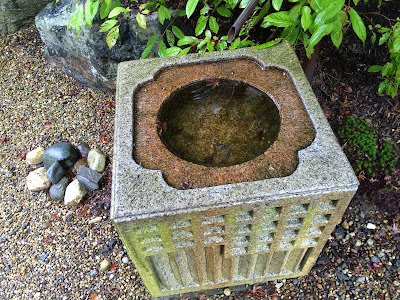Last weekend I had an opportunity to accompany my wife Catherine on a visit to Washington, DC. She was attending a conference and I wanted to use the opportunity to surprise her with a renewed marriage proposal and engagement ring in honor of our 25th wedding anniversary.
Given that we had met and fell in love in China, I wanted to perform the surprise proposal in a place that appropriately reflected the start of our relationship. Initially I thought I would pop-the-question at the United States Botanic Garden. After all, we love visiting gardens. However, it had occurred to me that there was a small secluded garden adjacent to the Freer and Sackler Galleries, one of our favorite Asian art museums (part of the Smithsonian).
It had been some time since I last visited the museum and had, in fact, forgotten the significance of the garden. As I investigated the location as the possible proposal site, I quickly realized how the garden was the perfect location for my plans.
Website: http://gardens.si.edu/our-gardens/haupt-garden.html
Given that we had met and fell in love in China, I wanted to perform the surprise proposal in a place that appropriately reflected the start of our relationship. Initially I thought I would pop-the-question at the United States Botanic Garden. After all, we love visiting gardens. However, it had occurred to me that there was a small secluded garden adjacent to the Freer and Sackler Galleries, one of our favorite Asian art museums (part of the Smithsonian).
It had been some time since I last visited the museum and had, in fact, forgotten the significance of the garden. As I investigated the location as the possible proposal site, I quickly realized how the garden was the perfect location for my plans.
Website: http://gardens.si.edu/our-gardens/haupt-garden.html
The garden is known as the Moongate Garden and it was designed by architect Jean Paul Carlhian. The design was inspired by the Temple of Heaven in Beijing, China.
Catherine and I at the Temple of Heaven in Beijing, 2011
The geometrical axial layout is centered around the cardinal points of a compass. There is granite and water throughout the garden, reflecting two of the of the Five Elements.
It truly is a place of quiet contemplation, and for my purpose, seclusion.
I also recognized the symbolic significance of this location for my plans - the circular spot at the center is similar to the Yuan Qiu (Circular Alter) located at the Temple of Heaven complex in Beijing. Yuan Qiu is essentially a square (representing Earth) with a three-tiered circular platform in which the Heaven's Heart Stone is located at the center. It literally marks the place where Heaven and Earth intersect.
Catherine and I standing upon Heaven's Heart Stone in Beijing, 2011
The Moongate Garden reflects these same features in its design.
What better place, then, to express my continued devotion to our love than the place where Heaven and Earth meet?
After much secretive planning, Catherine and I headed off to visit the Freer and Sackler Galleries, or so she thought. It was a beautiful day, the sky clearer and bluer than I can ever remember. It was, no doubt, a blessing from Heaven. We arrived early and no one was nearby, except a lone security guard. Although he initially rejected my request to take a photograph ("Its against policy..."), he very quickly changed his mind ("...but today I am going to ignore that policy"). Another blessing from Heaven. I handed him the phone/camera and joined Catherine who was standing upon the center stone.
Finding the words to convey the moment is beyond my abilities. I therefore offer the picture below as as a testament of my devotion to the women who has made me the happiest man in the world.
Our love knows no bounds and transcends both Heaven and Earth, and I can think of no greater place in which to demonstrate that love than the Moongate Garden.




































































